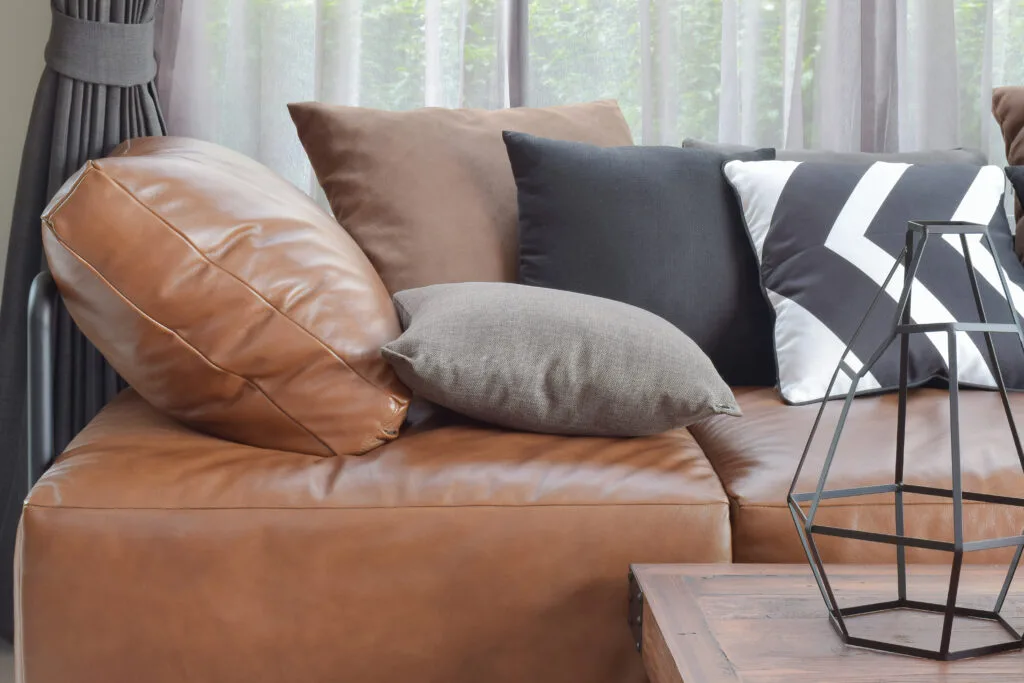 Modern, traditional, or eclectic—no matter your home’s current style, decorating with leather furniture has proven itself to be truly timeless. And it’s easy to see why. Leather is a natural material unlike no other. It’s durable, yet buttery-soft. It’s chic and luxurious. It’s stylish and versatile (so versatile in fact, that leather is now being used for flooring and even wall coverings). In a nutshell, it’s classic.
Modern, traditional, or eclectic—no matter your home’s current style, decorating with leather furniture has proven itself to be truly timeless. And it’s easy to see why. Leather is a natural material unlike no other. It’s durable, yet buttery-soft. It’s chic and luxurious. It’s stylish and versatile (so versatile in fact, that leather is now being used for flooring and even wall coverings). In a nutshell, it’s classic.
But does that mean you have to fill a room with leather furnishings? Quite the contrary. In fact, all you really need to warm up a room is a sofa or perhaps a chair or two. And, no matter what your color scheme is leather can be worked into the mix. All it takes is a few decorative accessories such as pillows or a throw to pull the colors within the space together cohesively.
If you haven’t given leather much thought, it may be time to learn about the benefits that come along with it.
What to Know About Leather
Leather is a complex fabric, so of course, there’s a lot to learn about it. Here’s some information worth knowing about leather.
Leather has longevity
While there are many durable fabrics out there, such as cotton and wool, leather (even faux leather) is still going to outlast it. Some ideal features about leather are that it doesn’t tear, it ages well, and it remains hardy against sun and heat. Newer, more modern leather doesn’t crack or peel and also retains its shape after stretching. And, unlike many fabrics out there, leather becomes more supple with age, making it a wise investment.
Leather is low maintenance
Leather is a wonderful fabric for those with busy lifestyles. Where many fabrics require costly procedures or special solvents to keep them clean, leather doesn’t. Although leather conditioners are available, oftentimes, all that is required is a simple wipe with a clean cloth to clean up dust and spills.
Leather can be incredibly comfortable
Not only is leather supple, but it also adjusts to your body temperature, making it the perfect choice for couches and chairs. You could say that leather is like skin because of its pores and ability to breathe.
Leather is extremely versatile
As mentioned earlier, leather— both real and faux— is being used in different capacities these days. Today, you can find leather used in flooring and wall coverings. Leather can also be used to cover items like tabletops and headboards. This versatility makes it easy to find ways to incorporate leather into just about any decor style.
Leather is higher quality
If you’ve even been car shopping, you know that cars with leather interiors have bigger price tags. It’s really no different when it comes to items in your home. Whatever is covered in leather will have more value than something that isn’t.
Types of Leather and Finishes
Types of leather can be broken down into several different categories— and there are some major differences between them. What makes them so different? Their quality.
Leather quality is described as grades. They are as follows (listed in order of quality):
- Full-Grain — leather with the complete grain intact
- Top Grain — leather from the top cut of the hide, that may have imperfections removed through a corrective process
- Split Grain (sometimes called “Genuine Leather”) — leftover leather that is often coated with a polymer and embossed to make it look like natural leather
- Bonded Leather — leather created from the scraps of other leather projects and then rolled up using an adhesive material
In regards to finishes, there are various terms used to describe the process. They are as follows (in order of quality):
- Aniline leather — where the tanned animal hide is dyed in a drum with aniline dye, a translucent, water-soluble synthetic dye without any insoluble pigments. In this process, the nontoxic dye fully penetrates the hide and doesn’t just coat the top.
- Semi-aniline leather — aniline-dyed leather that is treated with a light protective topcoat so it is somewhat protected against stains and fading. It has a more uniform finish but still has highs and lows and richness of color.
- Pigmented leather — created with hides that are not suitable for aniline or semi-aniline leathers.
Ways to Add Leather (Real or Faux) to Your Home
Often times, people equate leather with masculinity. True, leather can add a masculine feel to a space, but only if you let it. If you’re unsure how to add leather into your home without it taking over the space, here are some tips that may help:
- Pale accents such as cream or white accent pillows, throw blankets, rugs and accessories can soften the look of dark leather.
- Get balance by way of textiles and paint on walls and furniture. Color is a great way to make the space look more cozy and comfortable.
- Go for something small rather than not at all. In other words, if a sofa is too much leather for you, get a leather ottoman or accent chair instead.
- Consider having the leather dyed to something that suits your taste and decor more.
When the time comes to find fabrics and accessories to complement your leather furniture, stop by our showroom to see the beautiful selection we have to offer. You will find something for every home interior project from gorgeous drapery fabrics to lightweight cotton fabrics and luxurious Dupioni silk fabrics.

















